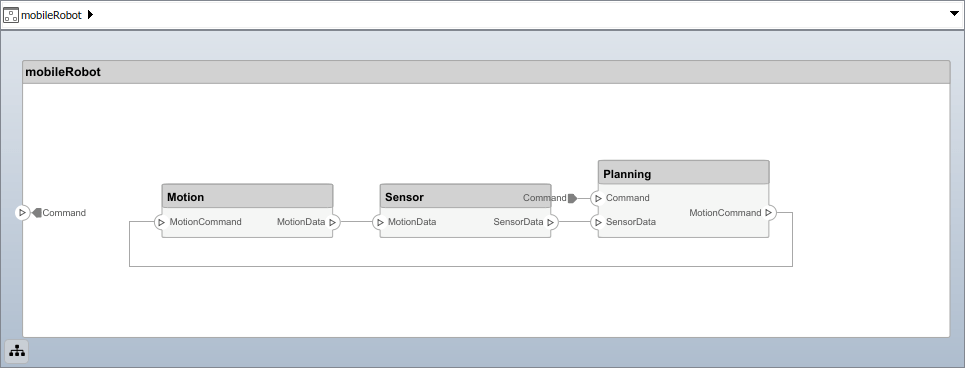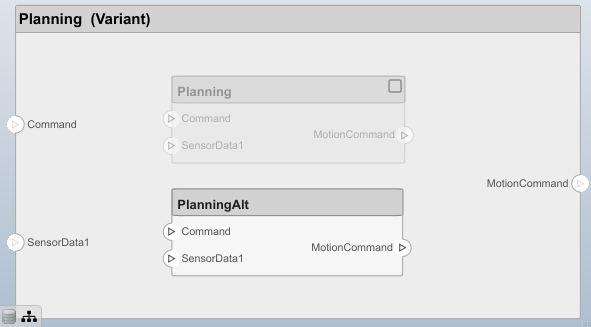systemcomposer.arch.Component
系统的作曲家组件
描述
一个组件对象表示System Composer™模型中的组件。这个类继承自systemcomposer.arch.BaseComponent。这个类派生自systemcomposer.arch.Element。
创建
在体系结构模型中创建组件。
模型= systemcomposer.createModel(“archModel”);Arch = get(模型,“架构”);component = addComponent(arch,“newComponent”);
属性
名字- - - - - -组件名称
特征向量
组件的名称,指定为字符向量。
例子:“newComponent”
数据类型:字符
父- - - - - -拥有组件的体系结构
架构对象
拥有组件的体系结构,指定为systemcomposer.arch.Architecture对象。
体系结构- - - - - -定义组件结构的体系结构
架构对象
定义组件结构的体系结构,指定为systemcomposer.arch.Architecture对象。对于引用不同体系结构模型的组件,此属性返回该模型的根体系结构的句柄。对于变体组件,体系结构是活动变体的体系结构。
OwnedArchitecture- - - - - -组件拥有的体系结构
架构对象
组件拥有的体系结构,指定为systemcomposer.arch.Architecture对象。对于引用体系结构的组件,此属性为空。对于可变组件,该属性是单个可变组件所在的体系结构。
港口- - - - - -组件端口阵列
组件端口对象的数组
组件端口的数组,指定为的数组systemcomposer.arch.ComponentPort对象。
OwnedPorts- - - - - -组件端口阵列
组件端口对象的数组
组件端口的数组,指定为的数组systemcomposer.arch.ComponentPort对象。对于引用组件,此属性为空。
位置- - - - - -组件在画布上的位置
以像素为单位的坐标向量
组件在画布上的位置,指定为坐标向量,以像素为单位[左上右下]。
ReferenceName- - - - - -组件引用的模型的名称
特征向量
如果链接组件,则组件引用的模型的名称,指定为字符向量。
数据类型:字符
IsAdapterComponent- - - - - -组件是否是适配器块
真正的或1|假或0
组件是否是适配器块,指定为逻辑1 (真正的)或0 (假)。
数据类型:逻辑
UUID- - - - - -通用唯一标识符
特征向量
模型组件的通用唯一标识符,指定为字符向量。
例子:91 d5de2c-b14c-4c76-a5d6-5dd0037c52df
数据类型:字符
ExternalUID- - - - - -唯一外部标识符
特征向量
唯一的外部标识符,指定为字符向量。外部ID将在模型组件的整个生命周期中以及通过保留模型的所有操作中保留UUID。
数据类型:字符
模型- - - - - -父母模型
模型对象
组件的父系统编写器模型,指定为systemcomposer.arch.Model对象。
金宝appSimulinkHandle- - - - - -金宝app仿真软件处理
数值
金宝app®组件句柄,指定为a双。此属性对于几个与Simulink相关的工作流和使用是必需的金宝app金宝app仿真软件需求™api。
例子:handle = get(object,'金宝appSimulinkHandle')
数据类型:双
金宝appSimulinkModelHandle- - - - - -金宝app父模型的Simulink句柄
数值
金宝app组件的父系统编写器模型的Simulink句柄,指定为双。此属性对于几个与Simulink相关的工作流和使用是必需的金宝app金宝app仿真软件的需求api。
例子:handle = get(object,'金宝appSimulinkModelHandle')
数据类型:双
对象的功能
createArchitectureModel |
从组件创建体系结构模型 |
create金宝appSimulinkBehavior |
创建Simul金宝appink行为并链接到组件 |
createSubsystemBehavior |
向组件添加子系统行为 |
createStateflowChartBehavior |
向组件添加状态流程图行为 |
linkToModel |
将组件链接到模型 |
inlineComponent |
从组件中删除参考体系结构或行为 |
makeVariant |
将组件转换为变量选择 |
isProtected |
查找组件引用的模型是否受到保护 |
isReference |
查找组件是否被引用到另一个模型 |
连接 |
创建架构模型连接 |
getPort |
从组件获取端口 |
applyStereotype |
将原型应用于架构模型元素 |
getStereotypes |
将原型应用到架构模型的元素上 |
removeStereotype |
从模型元素中移除原型 |
setProperty |
设置与应用于元素的原型相对应的属性值 |
getProperty |
获取与应用于元素的原型相对应的属性值 |
getPropertyValue |
获取建筑属性值 |
getEvaluatedPropertyValue |
从组件中获取属性的评估值 |
getStereotypeProperties |
获取元素上的原型属性名 |
hasStereotype |
查找元素是否应用了原型 |
hasProperty |
查找元素是否具有属性 |
getQualifiedName |
获取模型元素限定名 |
摧毁 |
移除模型元素 |
例子
以编程方式构建体系结构模型
使用System Composer™以编程方式构建架构模型。
构建模型
要构建模型,请添加一个包含数据接口、数据元素和值类型的数据字典,然后添加组件、端口和连接。为端口指定一个所属接口。在构建模型之后,您可以创建自定义视图来关注特定的考虑事项。您还可以查询模型,根据您指定的标准收集不同的模型元素。
添加组件、端口、连接和接口
创建一个模型并提取其体系结构。
模型= systemcomposer.createModel(“mobileRobotAPI”);arch = model.Architecture;
创建接口数据字典,并添加数据接口。向数据接口添加一个数据元素。将值类型添加到接口数据字典中。将数据元素的类型赋值给值类型。将数据字典链接到模型。
dictionary = systemcomposer.createDictionary(“SensorInterfaces.sldd”);interface = dictionary.addInterface“GPSInterface”);element = interface.addElement()“SignalStrength”);valueType = dictionary.addValueType()“SignalStrengthType”,“单位”,“数据库”,“描述”,“GPS信号强度”);element.setType (valueType);linkDictionary(模型,“SensorInterfaces.sldd”);
将更改保存到接口数据字典中。
dictionary.save
在“接口编辑器”中查看接口。

添加组件、端口和连接。将数据接口设置为ports,稍后将进行连接。
componentSensor = addComponent(arch,“传感器”);sensorPorts = addPort(componentSensor.)架构,{“MotionData”,“SensorData”}, {“在”,“出”});sensorPorts(2).setInterface(interface) componentPlanning = addComponent(arch,“规划”);planningPorts = addPort(componentPlanning. port)架构,{“命令”,“SensorData1”,“MotionCommand”}, {“在”,“在”,“出”});planningPorts(2).setInterface(interface) componentMotion = addComponent(arch,“运动”);motionPorts = addPort(componentMotion.)架构,{“MotionCommand”,“MotionData”}, {“在”,“出”});
上创建一个自有接口“MotionData”端口。在自有数据接口下添加一个自有数据元素。赋值数据元素"旋转”到单位设置为的值类型度。
ownedInterface = motionPorts(2).createInterface(“DataInterface”);ownedElement = owneinterface . addelement (“旋转”);subInterface = ownedElement.createOwnedType()“单位”,“度”);
在“接口编辑器”中查看接口。选择“MotionData”端口运动组件。在接口编辑器中,从字典视图来端口接口视图。

使用接口规则和默认名称规则连接组件。接口规则用于连接共享同一接口的组件端口。默认情况下,名称规则连接具有相同名称的组件上的端口。
c_sensorData = connect(arch,componentSensor,componentPlanning,“规则”,“接口”);c_motionData = connect(arch,componentMotion,componentSensor);c_motionCommand = connect(arch,componentPlanning,componentMotion);
添加并连接架构端口
在体系结构上添加一个体系结构端口。
archPort = addPort(arch,“命令”,“在”);
的连接命令需要一个组件端口作为参数。获取组件端口,然后连接。
compPort = getPort(componentPlanning;“命令”);c_Command = connect(archPort,compPort);
保存模型。
model.save
打开模型。
systemcomposer.openModel (“mobileRobotAPI”);
通过pressıng安排布局Ctrl + Shift +一个或者使用这个命令。
金宝appSimulink.BlockDiagram.arrangeSystem (“mobileRobotAPI”);

用原型创建和应用概要文件
概要文件是可以应用于任何模型的XML文件。您可以将带有属性的原型添加到概要文件中,然后用特定的值填充属性。与System Composer的内置分析功能一起,构造型可以帮助您优化系统的性能、成本和可靠性。
创建概要文件并添加原型
创建一个概要文件。
profile = systemcomposer.createProfile(“GeneralProfile”);
创建一个适用于所有元素类型的原型。
elemSType = addStereotype(profile,“projectElement”);
为不同类型的组件创建原型。您可以根据自己的设计需要选择这些类型。
pCompSType = addStereotype(profile)“physicalComponent”,“AppliesTo”,“组件”);sCompSType = addStereotype(profile,“softwareComponent”,“AppliesTo”,“组件”);
为连接创建一个构造型。
sConnSType = addStereotype(profile,“standardConn”,“AppliesTo”,“连接器”);
添加属性
向原型添加属性。您可以使用属性来捕获模型元素的元数据,并分析非功能性需求。在导入概要文件的任何模型中,这些属性被添加到原型应用到的所有元素中。
addProperty (elemSType“ID”,“类型”,“uint8”);addProperty (elemSType“描述”,“类型”,“字符串”);addProperty (pCompSType“成本”,“类型”,“双”,“单位”,“美元”);addProperty (pCompSType“重量”,“类型”,“双”,“单位”,‘g’);addProperty (sCompSType“develCost”,“类型”,“双”,“单位”,“美元”);addProperty (sCompSType“develTime”,“类型”,“双”,“单位”,“小时”);addProperty (sConnSType“unitCost”,“类型”,“双”,“单位”,“美元”);addProperty (sConnSType“unitWeight”,“类型”,“双”,“单位”,‘g’);addProperty (sConnSType“长度”,“类型”,“双”,“单位”,“米”);
保存配置文件
profile.save;
将概要文件应用于模型
将概要文件应用于模型。
applyProfile(模型,“GeneralProfile”);
对组件应用构造型。有些组件是物理组件,而其他组件是软件组件。
applyStereotype (componentPlanning“GeneralProfile.softwareComponent”) applyStereotype (componentSensor“GeneralProfile.physicalComponent”) applyStereotype (componentMotion“GeneralProfile.physicalComponent”)
将连接器构造型应用于所有连接。
batchApplyStereotype(拱,“连接器”,“GeneralProfile.standardConn”);
将通用元素原型应用于所有连接器和端口。
batchApplyStereotype(拱,“组件”,“GeneralProfile.projectElement”);batchApplyStereotype(拱,“连接器”,“GeneralProfile.projectElement”);
为每个组件设置属性。
setProperty (componentSensor“GeneralProfile.projectElement.ID”,“001”);setProperty (componentSensor“GeneralProfile.projectElement.Description”,"所有传感器的中心单元");setProperty (componentSensor“GeneralProfile.physicalComponent.Cost”,“200”);setProperty (componentSensor“GeneralProfile.physicalComponent.Weight”,“450”);setProperty (componentPlanning“GeneralProfile.projectElement.ID”,“002”);setProperty (componentPlanning“GeneralProfile.projectElement.Description”,“电脑”计划);setProperty (componentPlanning“GeneralProfile.softwareComponent.develCost”,“20000”);setProperty (componentPlanning“GeneralProfile.softwareComponent.develTime”,“300”);setProperty (componentMotion“GeneralProfile.projectElement.ID”,“003”);setProperty (componentMotion“GeneralProfile.projectElement.Description”,电机及电机控制器);setProperty (componentMotion“GeneralProfile.physicalComponent.Cost”,“4500”);setProperty (componentMotion“GeneralProfile.physicalComponent.Weight”,“2500”);
将连接的属性设置为相同。
connections = c_sensorData c_motionData c_motionCommand c_Command;为k = 1:长度(连接数)“GeneralProfile.standardConn.unitCost”,“0.2”);setProperty(连接(k),“GeneralProfile.standardConn.unitWeight”,“100”);setProperty(连接(k),“GeneralProfile.standardConn.length”,“0.3”);结束
添加层次结构
添加两个名为控制器和范围在运动组件。定义端口。通过应用连接器原型,将组件连接到体系结构并相互连接。架构图中的层次结构创建了额外的详细级别,用于指定组件的内部行为。
motionArch = componentMotion.Architecture;motionController = motionArch.addComponent(“控制器”);controllerPorts = addPort(motionController。架构,{“controlIn”,“controlOut”}, {“在”,“出”});controllerCompPortIn = motionController.getPort()“controlIn”);controllerCompPortOut = motionController.getPort(“controlOut”);motionScope = motionArch.addComponent(“范围”);scopePorts = addPort(motionScope。架构,{“scopeIn”,“scopeOut”}, {“在”,“出”});scopecompporttin = motionScope.getPort“scopeIn”);scopeCompPortOut = motionScope.getPort(“scopeOut”);c_planningController = connect(motionPorts(1),controllerCompPortIn);对于输出连接,必须指定接口元素c_planningScope = connect(scopeCompPortOut,motionPorts(2),“DestinationElement”,“旋转”);c_planningConnect = connect(controllerCompPortOut, scopecompporttin,“GeneralProfile.standardConn”);
保存模型。
model.save
通过pressıng安排布局Ctrl + Shift +一个或者使用这个命令。
金宝appSimulink.BlockDiagram.arrangeSystem (“mobileRobotAPI /运动”);

创建模型引用
模型引用可以帮助您按层次组织大型模型,并定义架构或行为,以便您可以重用。当组件引用另一个模型时,组件上的任何现有端口都将被删除,而被引用模型上存在的端口将出现在组件上。
创建一个新的System Composer模型。转换传感器组件转换为引用组件以引用新模型。的附加端口传感器组件,则必须更新所引用的模型“mobileSensor”。
referenceModel = systemcomposer.createModel(“mobileSensor”);referenceArch = referencmodel . architecture;newComponents = addComponent(referenceArch,“ElectricSensor”);linkDictionary (referenceModel“SensorInterfaces.sldd”);referenceModel。保存linkToModel (componentSensor,“mobileSensor”);

对链接的参考模型的体系结构和组件应用构造型。
referenceModel.applyProfile (“GeneralProfile”);referenceArch.applyStereotype (“GeneralProfile.softwareComponent”);batchApplyStereotype (referenceArch“组件”,“GeneralProfile.projectElement”)
向参考组件添加端口和连接。
sensorPorts = addPort(componentSensor.)架构,{“MotionData”,“SensorData”}, {“在”,“出”});sensorPorts (2) .setInterface(接口)连接(拱、componentSensor componentPlanning,“规则”,“接口”);连接(拱门,componentMotion componentSensor);
保存模型。
referenceModel。保存model.save
制作可变组件
你可以将规划组件转换为一个变体组件makeVariant函数。原始组件作为可用的变体选择之一嵌入到变体组件中。您可以在变体组件中设计其他变体选择,并切换活动选择。变体组件允许您在架构模型中以编程方式选择行为设计,以执行交易研究和分析。
[variantComp,choice1] = makeVariant(componentPlanning);
添加一个名为PlanningAlt。第二个参数定义名称,第三个参数定义标签。标签标识选择。主动选择是由标签控制的。
选择2 =添加选择(变量,{“PlanningAlt”}, {“PlanningAlt”});
在上面创建必要的端口PlanningAlt。
setactivchoice (variantComp,choice2) planningAltPorts = addPort(choice2)架构,{“命令”,“SensorData1”,“MotionCommand”}, {“在”,“在”,“出”});planningAltPorts (2) .setInterface(接口)
使PlanningAlt活跃的变种。
setActiveChoice (variantComp“PlanningAlt”)
通过pressıng安排布局Ctrl + Shift +一个或者使用这个命令。
金宝appSimulink.BlockDiagram.arrangeSystem (“mobileRobotAPI /规划”);

保存模型。
model.save
清理
取消这段代码的注释,并运行它来清理这个示例创建的工件。
% bdclose(“mobileRobotAPI”)% bdclose(“mobileSensor”)% 金宝appSimulink.data.dictionary.closeAll% systemcomposer.profile.Profile.closeAll%删除(“Profile.xml”)%删除(“SensorInterfaces.sldd”)
更多关于
定义
| 术语 | 定义 | 应用程序 | 更多的信息 |
|---|---|---|---|
| 体系结构 | System Composer体系结构表示一个组件系统,以及它们如何在结构上和行为上相互连接。您可以使用备用视图表示特定的体系结构。 | 不同类型的体系结构描述了系统的不同方面:
|
从视觉上组合架构 |
| 模型 | System Composer模型是包含架构信息的文件,包括组件、端口、连接器、接口和行为。 | 对模型进行操作:
System Composer模型存储为SLX文件。 |
创建带有接口和需求链接的架构模型 |
| 组件 | 组件是系统中重要的、几乎独立的、可替换的部分,它在体系结构上下文中实现明确的功能。组件定义一个体系结构元素,如功能、系统、硬件、软件或其他概念性实体。组件也可以是子系统或子功能。 | 组件表示为块,是体系结构模型的一部分,可以将其分离为可重用的工件。 | 组件 |
| 港口 | 端口是组件或体系结构上的一个节点,表示与其环境交互的一个点。端口允许信息流进出其他组件或系统。 | 有不同类型的端口:
|
港口 |
| 连接器 | 连接器是提供端口之间连接的线路。连接器描述了信息如何在组件或体系结构之间流动。 | 连接器允许两个组件进行交互,而无需定义交互的性质。在端口上设置接口以定义组件如何交互。 | 连接 |
MATLAB命令
你点击了一个对应于这个MATLAB命令的链接:
在MATLAB命令窗口中输入该命令来运行该命令。Web浏览器不支持MATLAB命令。金宝app

你亦可选择下列网址:
如何获得最佳的网站性能
选择中国网站(中文或英文)以获得最佳网站性能。其他MathWorks国家站点没有针对您所在位置的访问进行优化。
